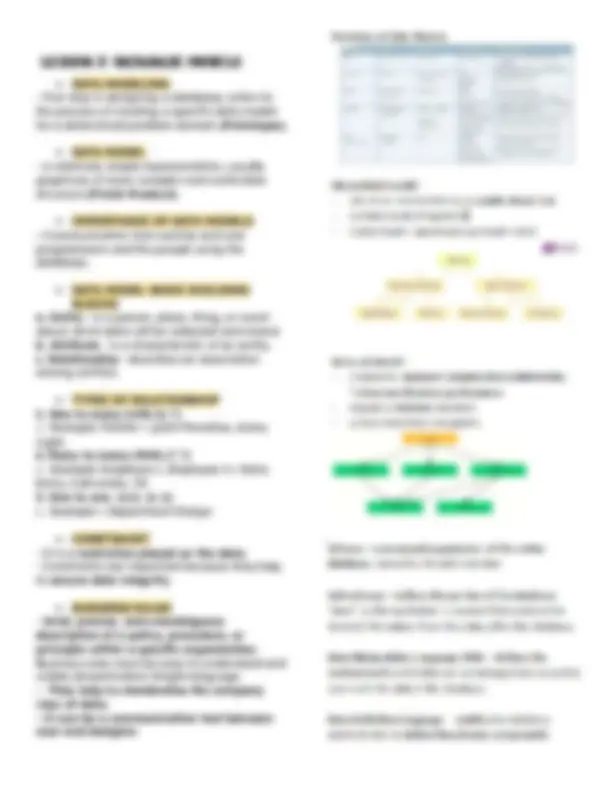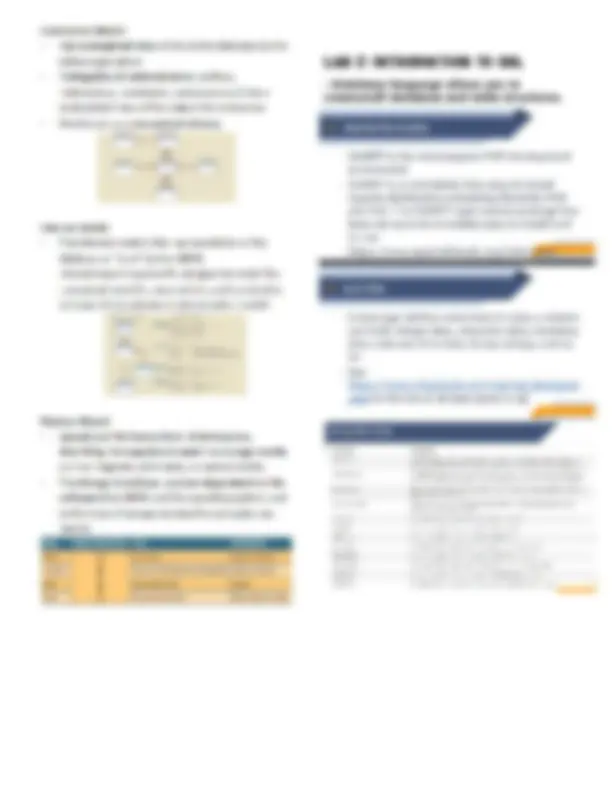






Study with the several resources on Docsity

Earn points by helping other students or get them with a premium plan


Prepare for your exams
Study with the several resources on Docsity

Earn points to download
Earn points by helping other students or get them with a premium plan
Community
Ask the community for help and clear up your study doubts
Discover the best universities in your country according to Docsity users
Free resources
Download our free guides on studying techniques, anxiety management strategies, and thesis advice from Docsity tutors
An overview of database systems, including the importance of databases, the differences between data and information, and the key components of a database management system (dbms). It also introduces the concept of data modeling and the different types of database models, as well as the basic building blocks of data models (entities, attributes, and relationships). Additionally, the document covers the basics of sql, the standard language for managing and manipulating relational databases, including common sql commands and their uses. This comprehensive introduction to database systems and sql would be valuable for students studying computer science, information systems, or related fields, as it lays the foundation for understanding how data is stored, organized, and accessed in modern information systems.
Typology: Study notes
1 / 8

This page cannot be seen from the preview
Don't miss anything!





➢ DATA VS INFORMATION a. DATA
b. INFORMATION
➢ INTRODUCING THE DATABASE
(DBMS) is a collection of programs that manage the database structure and control access to the data stored in the database.
a. Improved “data sharing” b. Improved “data security” c. Better “data inconsistency” d. Improved “data access” e. Improved “decision making” f. Increased “end-user productivity”
➢ TYPES OF DATABASE (users) a. Single-user database
b. Workgroup database ● Workgroup database- less than 50 users. ● Enterprise database- more than 50 users
➢ TYPES OF DATABASE (location) a. Centralized database- located in a single site. b. Distributed database- distributed across several sites.
➢ TYPES OF DATABASE (technology) a. Cloud database- a database that is created and maintained using cloud data services, such as Microsoft azure or amazon AWS.
➢ TYPES OF DATABASE (use) a. Operational database- primarily used for day-to-day transactional activities. b. Analytical database- designed for complex querying and data analysis to support business intelligence and decision-making process.
● Social Media- refers to web and mobile technologies that enable “anywhere, anytime, always on” human interactions. Websites such as google, facebook, twitter, and LinkedIn capture vast amounts of data about end users and consumers. This data grows exponentially and requires the use of specialized database systems.
➢ WHY DATABASE DESIGN IS IMPORTANT? ● Database design is all about how you
set up the structure to store user data, and it's super important. Even if you have a great Database Management System (DBMS), it won't work well
● ➢ EVOLUTION OF FILE SYSTEM DATA PROCESSING a. Manual File System- uses paper and pencils for record-keeping. b. Computerized file systems- relies on computers for managing records and data.
➢ BASIC FILE TERMINOLOGIES a. Data- raw facts b. Field- character or group of characters that has a special meaning. c. Record- logically connected sets of one or more files that describe a person, place, or thing. d. File- collection of related records.
(Problem with file systems) a. Lengthy development times b. Di�culty of getting quick answers c. Complex system administration d. Lack of security and limited data sharing e. Extensive programming
a. Structural dependence – access to a file is dependent on its structure. b. Structural independence – changing the file structure without a�ecting the applications ability to access the data.
➢ DATA REDUNDANCY a. It exists when the same data is stored unnecessarily at di�erent places. b. Poor data security c. Data inconsistency d. Data entry errors e. Data integrity problems
➢ DBMS FUNCTION
- Database language allows you to create/edit database and table structures.
user’s database schema
have null value
have duplicate values
table. A combination of a NOT NULL and UNIQUE. Ensures that a column have a unique identity
table
column (when no value is given)
(adds, modifies, or deletes attributes or constraints)
based on a query in the user’s database schema
(and its data)
one or more tables or views
based on a conditional expression
based on one or more attribute
rows based on a condition
on one or more attributes
one or more table’s rows
table
expressions
expressions
value is within a range
is null
matches a given string pattern
matches any value within a value list
any rows
non-null values for a given column
found in a given column
found in a given column
given column
given column
development environment, completely free, easy to install Apache distribution containing MariaDB, PHP, and Perl.
value a column can hold: integer data, character data, monetary data, date and time data, binary strings, and so on. e.g. varchar, int, decimal, char…
data in a table. e.g. Primary Key, Unique, Not Null, Foreign Key, Check, Default